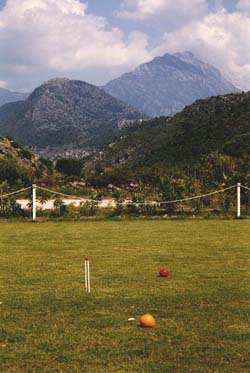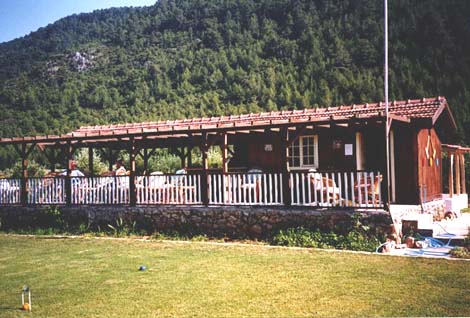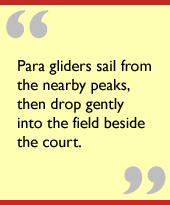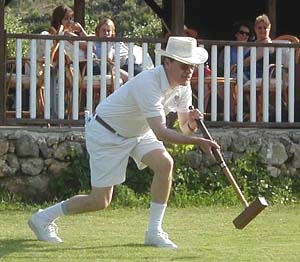

|
Back to |
| The Front Page |
| News & Features |

|
Croquet Frontiers: Beachhead In Southern Turkey |
|||||||||
|
by Pierre G. Dunn Posted July 19, 2002
|
|
||||||||
Pierre Dunn and his wife Linda wanted to experience, in Pierre's words, "different ways of living." So she did her master's work in Teaching English to Speakers of Other Languages. This led them first to Japan, where Linda's university job anchored them professionally while Pierre did part-time language work. From their Japanese base, they explored all of Southeast Asia for eight years, then sojourned briefly in Oregon before moving on to Hungary, and finally to Turkey, which they have found to be an a more open and secular society than they expected. With good pay and low living expenses, the Dunns are finding life in Turkey most agreeable. Not the least of its attractions are weekend excursions to exotic places - by Mercedes bus! Buses are a primary form of transport in Turkey, and the service is superior, complete with air conditioning and attendants who bring you drinks and little cakes. Pierre and Linda would visit more often this charming seaside inn with a croquet court and a revolving coterie of competitive players - if only it were not nine hours by bus from their Ankara home.
There were cities in Anatolia 9500 years ago. The Hittites established their first kingdom about 1600 BC, and an Empire some 150 years later, a couple of hundred years before the Trojan War. Other cultures came, flourished, and faded, including King Midas' Phrygians, King Croesus' Lydians, several groups of Hellenistic Greeks, the Cimmerians, the Persians under Cyrus and his descendants, Alexander the Great's Macedonians and allied Greeks, the Galatians, the Romans and their heirs in the Byzantine Empire, the Seljuk Turks in the 11th century, the Ottomans in the 13th century, and modern day Turkey in the 20th century.

|
| A view of the court shows the ancient abandoned Greek village on the mountainside above. |
Fethiye is a small city of about 25,000 located approximately where the southern end of Turkey's Aegean coast meets the western end of Turkey's Mediterranean coast. Once dependent on fishing and trade, the city is now one of the many reasonably priced vacation centers that flourish in the mild and pleasant bays of Turkey's ruggedly mountainous western and southern shores.
The true hotbeds of tourist activity around Fethiye are found as much in the outlying suburbs as in the yacht basin of the city proper. Ölüdeniz, a beachside resort just over the ridge from Fethiye, is packed with resort hotels, tourist shops, eateries, and nightspots. Kaya Köy (Kaya Village) is just south of Ölüdeniz, over another ridge, and has not yet succumbed to the temptations of over development.
One of Kaya Köy's most interesting features, in fact, is the abandoned Greek village that hangs forlorn on the slopes above the newer village in the valley. One of the terms of the agreement that ended the Greek-Turkish conflict of the early 1920s (which immediately followed Turkey's defeat in World War I and the final collapse of the Ottoman Empire) was that all Greeks in Anatolia, of which there were many, were to be forcibly repatriated to Greece, and all Turks in Greece, of which there were also many, were to be sent back to Turkey. It was an earlier and slightly less deadly experience with ethnic cleansing than that which visited Greece's northern neighbors some 70 years later.
It transpired that the Turks brought in to replace Kaya's Greeks didn't take to hillside living and preferred to spread out among their lower-lying fields of wheat and their olive and fruit orchards, and the empty Greek houses have been slowly crumbling ever since.

|
| Visitors like to amble through the ruins of the ancient Greek settlement. |
It is in Kaya Köy that the Ancient & Royal Kaya Croquet Club was founded by John Laughland and Jon Bowker. Two enterprising expats who wandered the world for several years before settling in Kaya Köy, Big John and Little Jon have now become established members of the community, both refurbishing local buildings for use by vacationers while discouraging development of the hotel-restaurant-souvenir-stand strips that have blighted other tourist spots. The friendly respect in which they're held is clear in the smiles and waves they receive from every farmer, shopkeeper, and cafe owner they pass as they roll back and forth down Kaya's quiet roads showing visitors the local sights, tending to their burgeoning businesses, and, most importantly, keeping the Croquet Club's bar stocked with plentiful supplies of Efes Pilsen, the preeminent Turkish beer (whose local distributor is also one of Turkish croquet's prime backers).
In 1998, what is now the Club was a farmer's field adjoining Kaya Cottages, a property co-owned by Bowker and consisting of a cluster of carefully restored old village houses now let out to visiting vacationers (for more information - which may include additional pictures of the croquet facilities by the time you read this - go to the Kaya Cottages website.
In 1999, Laughland and Bowker cleared the land, laid out the court, took off the top layer of ground, leveled the area with new topsoil, seeded it with three kinds of grass (each prospering best in different seasons), filled with sandy river silt, and rolled the court. They built a clubhouse, found equipment - from Jaques balls and commercially produced mallets to locally crafted hoops and beechwood mallets suitable for novices - and began to play.

|
| The clubhouse is tucked into the mountainside overlooking the croquet lawn. |
The venture is proving successful in several ways. The Club is essentially a private social organization, which makes its facilities available to members and their guests. Among these guests are the vacationers who find accommodations with a consortium of hotels and guesthouses in the Fethiye area. During the week, the court is available to those who sign up to use it, and occasionally even to those who just drop by. Every Saturday, the Club hosts a catered dinner-and-croquet evening for guests who sign up for the affair, then provides basic croquet instruction and manages croquet matches for the attendees.

This year, the Club has found itself operating in the black, as word spreads about good food and good fun, as visitors new to the area decide to try a new experience, and as old acquaintances return to give it another go. Among those coming back are groups of Para gliders who sail from high up the nearby peaks, then drop gently after a long flight into the field beside the court. They amble over to the clubhouse for a relaxing glass of beer, then select mallets and play some croquet.
The Club's court is not perfect. It has been improved over its three years of life, but it still has some way to go. The remaining surface irregularities are made up for somewhat by the fact that the court is 30 meters wide instead of 35 yards, and that the hoops are lighter and a bit wider than official dimensions would require. The lawn is not cut as short as it could be, but the grass is not yet dense enough to support such a severe trim. As a result, rushes are a bit difficult and the balls tend to jump around more than they should, but when compared to backyard courts - and, indeed, to all the other courts in Turkey (an easy task!) - this is a most satisfactory compromise. It's not suitable for a serious tournament, but it provides locals a very suitable place to practice skills and tactics, and offers vacationing visitors a thoroughly pleasant introduction to a sport they might not consider exploring in the more mundane precincts of home.

|
| The writer wows the clubhouse crowd with a dramatic follow-through. |
But what is in store for tourism in Turkey in general? The government is in crisis as the cabinet collapses and the prime minister who holds it all together fights serious health problems. A member of NATO, Turkey is deeply concerned about the multiple effects that could result from a U.S.-led war with neighboring Iraq. The economy, dependent on the stability of the government and on trade with neighboring countries (the embargo on trade with Iraq has already hammered Turkey severely), has also been reeling from the depleted flow of tourist dollars and euros since September 11 frightened the world's travelers and ongoing crises have tightened corporate purse-strings.
It doesn't seem like a good time to go into the croquet business in Turkey with an eye to making a livelihood at it. But, ah, that sea, those mountains, these delicious kebabs, that cold beer under a bright blue sky, that green lawn and the comforting sound of a cross-court roquet! Do we really need to insist on the practical?